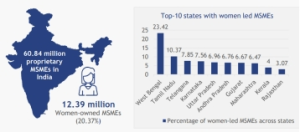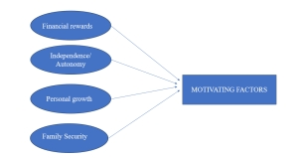CHALLENGES AND PERSPECTIVES OF A TRANSITIONAL WOMEN ENTREPRENEURS
Dr.S.Catherine & Dr.S.Joyce
Assistant Professor, SRM Institute of Science and Technology, Vadapalani, cathrins@srmist.edu.in
Associate Professor, Sathyabama Institute of Science and Technology. joyssolo84@gmail.com
ABSTRACT
Women entrepreneurship is considered by many researchers as an imminent phenomenon of the 21st century, especially in developing countries. In this context, the main purpose of this research was to assess the driving factors, challenges, and perspectives of women entrepreneurship in a post-communist country context. Transitional Entrepreneurship focuses on issues facing entrepreneurs from communities that face significant adversity in launching ventures and for whom the path involves substantive life transitions. The study results reveal that even though there are no significant differences between the percentage of women who feel that they are being discriminated against and the percentage of female entrepreneurs who perceive that their gender has positively affected the business growth, there is a positive significant difference regarding the percentages of women entrepreneurs who have been supported by their families and partners and those who have received heritage from their families. Special attention is addressed to the different factors that women experience in terms of entrepreneurial development.
Introduction:
Women’s participation in the economy is essential for sustainable economic development, gender equality, and poverty alleviation. McKinsey Global Institute (MGI) estimates that India could boost its GDP by USD 0.7 trillion by bringing 68 million more women into India’s workforce by 2025. The World Bank reports that India could increase GDP growth by 1.5 percentage points by including 50% of the women in the workforce. However, India’s female labor force participation rate (FLFPR) declined from 32% in 2005 to 19% in 2021, 27 percentage points less than the global average. Female entrepreneurs face limited access to credit, capacity-building that remains concentrated in limited sectors, lack of information, absence of networking, and low market linkages. These challenges and adverse social norms impact their entrepreneurial ambitions and aspirations. The Government of India has undertaken several initiatives to promote female entrepreneurship at different levels. NITI’s WEP platform is a crucial central initiative to stem the stagnation of female entrepreneurship in India.
Source : Share of MSMEs and top-10 states in share of MSMEs.

Research Question:
What are the motivational factors driving TE among women?
Entrepreneur Transitional entrepreneurship is the concept that explicates in theory and practices the social, institutional, cultural, and economic adversities facing marginalized entrepreneurial actors in the process of pursuing new venture creation and achieving positional advancement and how these different marginalized groups cope with these issues (Pidduck and Clark 2021). Motivating factors, which can be either internal or external to the entrepreneur, classified motivators into four categories: financial rewards (extrinsic rewards), independence/autonomy, personal growth (intrinsic rewards) and family security.
Figure 1: Conceptual Model.

Bruton et al. (2021) describe a set of entrepreneurs who launch a series of business ventures in their host countries to accomplish significant life aspirations or career transitions (Old Dominion University 2021). However, Nair and Chen (2021) define TE simply as a unique form of entrepreneurship venturing found among members of communities who were able to overcome significant adversity and challenges to launch new ventures as pathways to substantive life transitions. There needs to be more academic work on who is a transitional entrepreneur. From the viewpoint of Nair and Chen (2021), a transitional entrepreneur is an entrepreneur from a disadvantaged community who overcomes life adversity and challenges by establishing a new venture to improve their life transition or career. A transitional entrepreneur sets up a business venture to accomplish significant life aspirations or career transitions.
Transitional entrepreneurs as follow the four stages of conception, gestation, infancy, and adolescence in creating new ventures in their operating environments. (Delmar and Davidsson 2000; Wagner 2006). Transitional entrepreneurs are viewed as a set of marginalized and traumatized entrepreneurs operating in an environment with non-inclusive transitional justice. They cannot hence make decisions about the future that render them largely incapable of making optimal positive contributions. The four groups focused on in this study also qualify as necessity entrepreneurs and nascent entrepreneurs. The latter is a concept that loosely refers to people who independently commit personal resources, ideas, and time to establishing new businesses on their own despite all odds (Wagner 2006). The six driving forces of nascent entrepreneurs throughout their transitional stages are self-realization, financial success, roles, innovation, recognition, and independence (Carter et al. 2003). Furthermore, it is proven that nascent entrepreneurs flourish and get their businesses up and running because they are motivated by nonfinancial outcomes, perceived support from social networks/contacts, and the institutional environment.Transitional women entrepreneurs, referring to women who are transitioning into entrepreneurship, face a unique set of challenges and opportunities. Navigating this transitional period requires resilience, adaptability, and a strategic approach. Here are some challenges and perspectives that transitional women entrepreneurs might encounter:
Challenges:
Cultural and Societal Norms: Societal expectations about women’s roles can be a barrier. Entrepreneurship might be seen as unconventional for women in certain cultures.
Lack of Support: Limited family or community support due to ingrained gender biases can create hurdles.
Access to Resources:
Financial Constraints: Limited access to capital and financial resources can impede the start of a business venture.
Limited Networks: Women might have smaller professional networks, affecting access to mentors, investors, and collaborators.
Work-Life Balance:
Family Responsibilities: Balancing family responsibilities with entrepreneurial pursuits can be overwhelming, requiring efficient time management.
Social Expectations: Women might face judgment or guilt from society for prioritizing career over traditional roles.
Confidence and Self-Belief:
Impostor Syndrome: Feeling unworthy of success or fearing being exposed as a “fraud” is a common challenge, especially in male-dominated industries.
Lack of Role Models: Limited visibility of successful women entrepreneurs can make it hard to visualize their own success.
Market Challenges: Potential bias from clients, partners, or investors can affect business opportunities and negotiations. The Product/Service Fit gives to understanding of market needs and adapting offerings to suit market demands can be challenging.
Perspectives:
Investing in education and skill development can enhance confidence and competence. Actively participating in entrepreneurial networks can provide mentorship and collaborative opportunities. Acquiring financial literacy is crucial. Understanding funding options, managing finances, and budgeting are key skills. Exploring alternative funding sources like crowdfunding or microloans can circumvent traditional financial barriers. Building Supportive Networks by Surrounding women with supportive individuals, both personally and professionally, can provide encouragement and advice. Advocacy for women entrepreneurs’ rights and opportunities can bring about positive change at a societal level. Seeking mentor ship from successful women entrepreneurs can provide valuable insights and boost confidence. Cultivating a growth mindset and believing in their abilities can help overcome self-doubt.
Thorough market research helps in understanding customer needs, leading to better product/service development and marketing strategies. Embracing innovation and adapting to market trends can create a competitive edge. Implementing flexible work arrangements and involving family members in the business, where possible, can ease the work-life balance challenge. Prioritizing self-care and mental well-being is essential for managing stress and maintaining resilience.
Conclusion: transitional women entrepreneurs face challenges rooted in societal norms and gender biases. However, with the right support, education, and mindset, these challenges can be overcome. Building a supportive community, acquiring necessary skills, and embracing innovation are key steps toward achieving entrepreneurial success in the face of transition.
Reference:
1. Bruton, Garry D., Jayarethanam Pillai, and Naiheng Sheng. 2021. Transitional entrepreneurship: Establishing the parameters of the field. Journal of Developmental Entrepreneurship 26: 2150015.
2. Bunduchi, Elena, Valentina Vasile, Calin-Adrian Comes, and Daniel Stefan. 2019. Macroeconomic determinants of remittances: Evidence from Romania. Applied Economics 51: 3876–89.
3. Bylund, Per L., and Matthew McCaffrey. 2017. A theory of entrepreneurship and institutional uncertainty. Journal of Business Venturing 32: 461–75.
4. Carree, Martin A., and A. Roy Thurik. 2010. The impact of entrepreneurship on economic growth. In Handbook of Entrepreneurship Research. New York: Springer, pp. 557–94.
5. Carter, Nancy M., William B. Gartner, Kelly G. Shaver, and Elizabeth J. Gatewood. 2003. The career reasons of nascent entrepreneurs. Journal of Business Venturing 18: 13–39.
6.Delmar, Frèdéric, and Per Davidsson. 2000. Where do they come from? Prevalence and characteristics of nascent entrepreneurs. Entrepreneurship & Regional Development 12: 1–23.
7. Wagner, Joachim. 2006. Nascent entrepreneurs. In The Life Cycle of Entrepreneurial Ventures. Boston: Springer, pp. 15–37.
8. Nair, Anil, and Li-Wei Chen. 2021. Transitional Entrepreneurship. Journal of Developmental Entrepreneurship 26: 1–11.
9. Suresh, N., & Bhavadharani, S. (2021). An Empirical Study on the Impact of Passenger Loyalty Program on Passenger Retention with Reference to Air India. Productivity, 62(1).
10. Suresh, N. V., & Rexy, V. A. M. (2024, February). An Empirical Study on Empowering Women through Self Help Groups. In 3rd International Conference on Reinventing Business Practices, Start-ups and Sustainability (ICRBSS 2023)(pp. 957-964). Atlantis Press.
11. Bruton, Garry D., Jayarethanam Pillai, and Naiheng Sheng. 2021. Transitional entrepreneurship: Establishing the parameters of the field. Journal of Developmental Entrepreneurship 26: 2150015.
12. Bruton, Garry D., Jayarethanam Pillai, and Naiheng Sheng. 2021. Transitional entrepreneurship: Establishing the parameters of the field. Journal of Developmental Entrepreneurship 26: 2150015.
